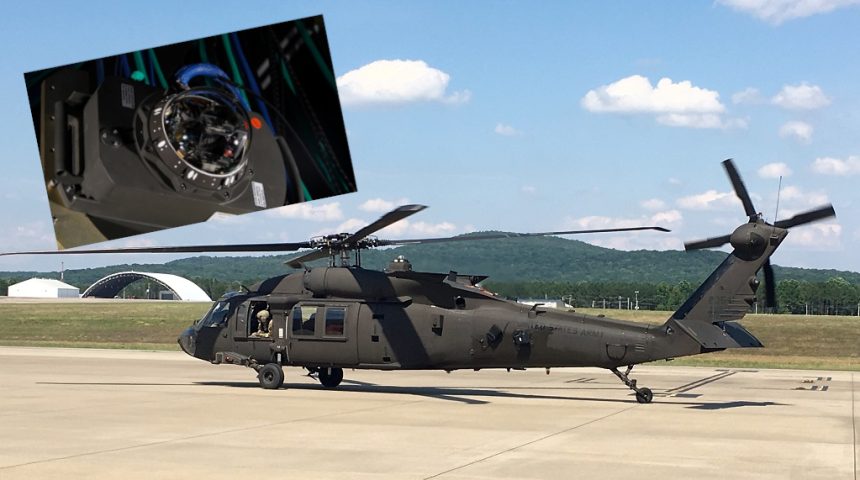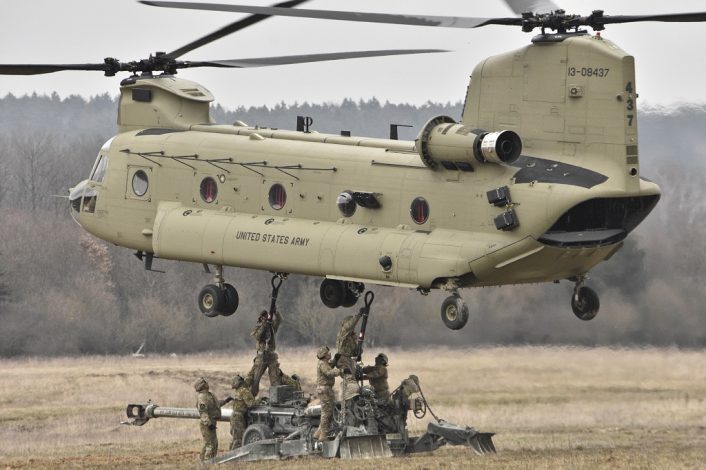The new CIRCM system will equip all the service’s current helicopters, beginning from the UH-60M Black Hawk, and the Future Vertical Lift helicopters in development.
The U.S. Army awarded Northrop Grumman a contract to begin the full-rate production of the laser-based Common Infrared Countermeasure (CIRCM) system on April 30, 2021. The firm-fixed-price contract, worth slightly less than 1 billion USD, will procure an unspecified number of CIRCM systems to equip all the helicopters currently serving in the U.S. Army, beginning from the UH-60M Black Hawk, as well as the winners of the competitions within the Future Vertical Lift program, which will replace the current helicopter fleet.
CIRCM, which is being pitched for all rotary wing, tilt-rotor and small fixed-wing aircraft across the Defense Department, is a lightweight dual-jammer Directional Infrared Counter Measures (DIRCM) system designed specifically to protect aircraft from InfraRed-guided missiles. Northrop Grumman says that the system is built on open architecture to work with existing hardware and uses a compact pointer/tracker, a lightweight Commercial Off-The-Shelf (COTS) processor and advanced Quantum Cascade Laser (QCL) technology for greater reliability and scalability.
As described by the Army, CIRCM is part of a suite of infrared countermeasures that also includes a Missile Warning System (MWS) and an Improved CounterMeasure Dispenser (ICMD) for flares and chaff. The Army’s current MWS is the Common Missile Warning System (CMWS) with the third-generation electronic control unit (ECU), which is responsible for detecting and declaring on an IR threat. Both CIRCM and the ICMD receive the handoff from CMWS and provide appropriate countermeasures to defeat the threat.
A brief description of the CIRCM’s functioning can be found in the (unclassified) FY21 Army Aircraft Procurement Budget (Line Item Number: 5399AZ3537): “CIRCM receives an angular bearing handoff from the MWS, employs a pointing and tracking system which acquires the handed-over threat and tracks the incoming missile during and after motor burnout. CIRCM jams the missile by using modulated laser energy in the missile seeker band, thus degrading the tracking capability of the missile and causing it to miss the aircraft.”
The contract award follows years of development, test, evaluation in collaboration with the U.S. Army and an initial production of 100 units already delivered, including CIRCM Quick Reaction Capability systems. Back in March 2021, the Army declared the system operationally suitable, effective and ready for full-rate production following a successful six-month Initial Operational Test and Evaluation (IOT&E) activity. The delivery of all contracted CIRCM units is expected to be completed by 2026.
CIRCM testing and the Army’s first quadruple threat defeat
The first examples of CIRCM were delivered in late 2016, entering the IOT&E phase in 2019 at the Redstone Test Center at Redstone Arsenal, Alabama, where the system was first installed on the UH-60M. During the rigorous testing, the system was flown through a multitude of scenarios and environments, including air assault, air movement and aeromedical evacuation missions in both day and night environments, to assess CIRCM’s ability to detect, engage and defeat threats.
Some more details about the testing were disclosed in the citation for the 2020 Army Acquisition Executive’s (AAE) Excellence in Leadership Product Manager Team of the Year presented to the Product Manager Infrared Countermeasures (PdM IRCM) team of the Project Manager Aircraft Survivability Equipment (PM ASE):
“A major leap in technology, Common Infrared Countermeasure (CIRCM) provides significant weight and power reductions while increasing combat capability to Army aviation. With direct oversight from the Army Test & Evaluation Command and the Director of Operational Test & Evaluation, CIRCM flew 2,303 open-air flight test events on operational aircraft and performed a Logistics Demonstration soldier touch-point to stress end-to-end logistical support and maintainer performance. At a White Sands Missile Range capstone event, the system achieved 12 successful free flight missile events against single threats, 4 successful free flight events against dual threats, and the Army’s first quadruple threat defeat. Lastly, the program achieved First Unit Equipped with the 1st Air Cavalry Brigade three months ahead of the Acquisition Program Baseline ‘Objective’ date.”
CIRCM current and future integration
CIRCM is set to replace the older and heavier BAE AN/ALQ-212 Advanced Threat Infrared Countermeasures (ATIRCM) that, while being described by the U.S. Army as highly combat effective, failed to be deployed on all the service’s helicopters as planned. Because of the weight, the system could not be installed on AH-64 Apaches and UH-60 Black Hawks, but only on CH-47 Chinooks.
As an interim solution while CIRCM was being developed, the Army acquired a number of Northrop Grumman Large Aircraft Infrared Countermeasure (LAIRCM) systems that, even if they experienced a somewhat troubled integration, were this time installed also on the UH-60 and AH-64. Some notable users of the AN/AAQ-24 LAIRCM are the heavily modified helicopters of the elite 160th SOAR (Special Operations Aviation Regiment).
The entire CIRCM system is divided in two smaller kits, as mentioned in the FY21 Army Aircraft Procurement Budget: “The CIRCM A-Kit includes mounting hardware, wiring harnesses, and other components necessary to install and interface the mission kit on host aircraft, ensuring the mission kit is functionally and physically operational with a specific host aircraft type. The CIRCM B-Kit is the mission kit (laser, pointer tracker, and controller) required to achieve near spherical coverage for an aircraft.”
After the installation on the current helicopters of the U.S. Army, CIRCM has been proposed for the installation on the Future Vertical Lift helicopters, together with the AN/APR-39E(V)2 digital Radar Warning Receiver/Electronic Warfare Management System. The latter, the next generation of the APR-39 RWR that has been in service for decades, is designed to detect, locate and identify sophisticated radio frequency-guided weapons and threats that are becoming more widely used in contested airspaces throughout the world.
As you may know already, two FVL sub-programs are in the works: the Future Long Range Advanced Aircraft (FLRAA), a medium size assault/utility aircraft that will replace the UH-60 Black Hawk; and the Future Attack Reconnaissance Aircraft (FARA), a light armed reconnaissance helicopter that will be the successor of the retired OH-58 Kiowa Warrior. Bell and Sikorsky have been selected as the finalists in both the competitions, submitting an advanced development of the V-280 Valor and the Defiant X, respectively, for FLRAA and the B-360 Invictus and the Raider X, respectively, for FARA.










